7+ SAMPLE Brand Pyramid
-
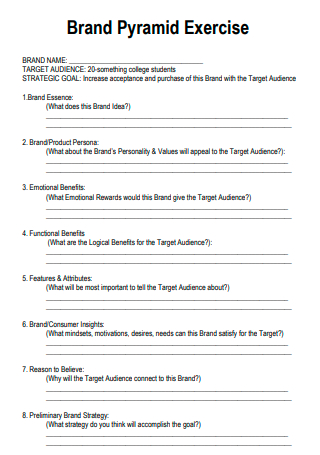
Brand Pyramid Exercise
download now -
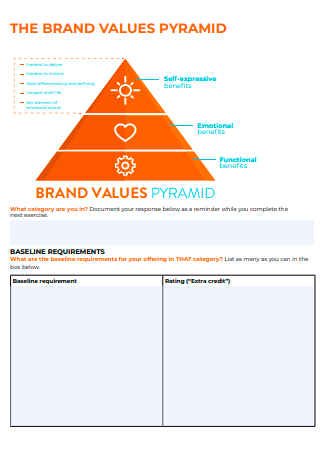
Brand Values Pyramid
download now -
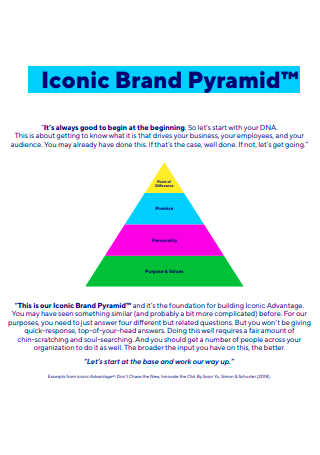
Iconic Brand Pyramid
download now -
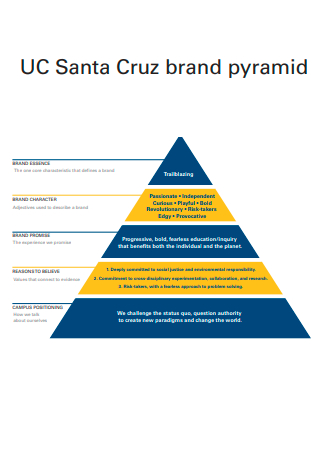
Brand Pyramid Example
download now -

Personal Brand Pyramid Exercise
download now -
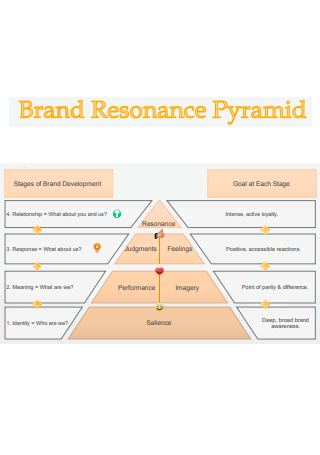
Brand Resonance Pyramid
download now -
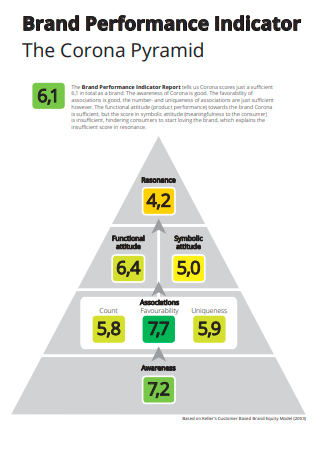
Brand Performance Indicator Corona Pyramid
download now -
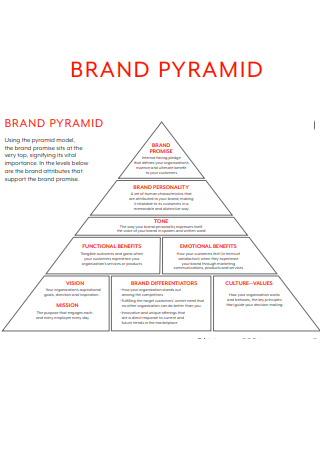
Brand Pyramid in PDF
download now
What Is a Brand Pyramid?
A brand pyramid represents a visual framework that answers relevant and fundamental questions about a brand’s identity and market positioning in itself and within an industry. Developing a brand pyramid for an organization enables it to communicate with various teams and departments, together with its members, the brand’s essence, personality, core functionality, and the emotional and material benefits the organization wants to translate to its audience. It is an immensely powerful and valuable tool to convey a brand’s vision to the public and an effective method for teams to start developing a brand strategy. Despite the brand pyramid being a practical tool to craft a brand’s overall identity, it is advisable to use the framework only after the organization already has a clear foundation and outline of a brand’s identity. It is also wise for an organization to have a firm organizational presence, culture, and background through build an organizational mission and purpose, vision for the company’s future, the specific needs of the business’s target market and audience, the definition of the brand’s personality, and the core values that guide the company into future actions and sound decisions.
According to a journal article from the SAGE journals, entitled An Experimental Application of the Brand Equity Pyramid Using a Healthy Movement Product Brand, there is a significant effect on how individuals perceive a particular brand and product through its repeated exposure to stimuli.
Components of a Brand Pyramid
As from tradition, brand pyramids are brand positioning framework documents that answer the most fundamental questions through a diagram that enables individuals to easily communicate and share information across different departments of the organization. Creating the brand pyramid forces a consensus towards senior management to detail what the company wants to be, who it wants to serve, why it wants to serve the specific market, how it makes the customers feel, and what core values the company has. Brand pyramids have five principal components, and the section below tackles these components and their significance in developing a brand.
How To Develop a Comprehensive Brand Pyramid
A brand pyramid is a valuable framework designed to communicate various marketing messages and positions of a brand. However, if management and teams cannot deliver an organized approach to construct a branding strategy, it becomes challenging to develop a practical, effective, and successful brand pyramid document. Constructing the brand pyramid helps an institution explain the significance of the brand and what makes it unique from industry competitors. The brand pyramid is also responsible for crafting a distinct identity that customers remember. The section below elaborates on the steps in developing a comprehensive brand pyramid for an organization.
1. Analyze the Current Branding Approach
The first step to creating a brand pyramid is to decide whether the current branding approach the company implements generates the desired outcomes and reaches the appropriate audiences. Perform a comparison between the current customer base and the ideal customer that the organization wants to attract, outlining the accomplished and unaccomplished branding goals. Whether an institution wants to be a pioneering organization in a certain field or to be known as the best company offering customer services, positive branding helps a company convey its message clearly and effectively.
2. Decide the Qualities that Require Emphasis
The next step to take is to develop a list of a brand’s unique features and characteristics and identify which of these require emphasis. If an organization wants to increase brand recognition and awareness of being a trustworthy manufacturer or a friendly source of expert opinions, not only to its customers but also to a target audience, the organization must put work into emphasizing these qualities. Depending on their respective industries, a company can stress the quality of its products, the convenience of acquiring services, or the efficiency of its staff members.
3. Craft the Brand Pyramid
After accomplishing the first two steps, an organization can start creating its brand pyramid, working towards a direction where it makes the most sense, following the different layers of the pyramid. One of the sections tackles the products and services that a brand offers its customers, where it states the features and attributes of a product or service that an organization offers and provides its consumers. Another section of the pyramid focuses on the rational benefits the brand gives, including the various characteristics that make a brand desirable to the market. An organization must list and consider the product and service quality, the niche a brand fills, and the relationship the service employees supply. The third section of the pyramid deals with the feelings and emotions a brand wants its customers to experience when they interact with offered products and services. Companies can utilize social groups, customer surveys, feedback questionnaires, and social media polls to generate data on how customers perceive the brand. The fourth section of the brand pyramid identifies a brand’s personality, using various adjectives to describe the brand while keeping in mind the qualities that an organization wants its customers to associate with the brand. Lastly, there must be a statement of the brand’s essence, similar to creating a simple and understandable mission statement to communicate the core values and pillars of the brand.
4. Design the Brand Pyramid
When designing the brand pyramid, ensure that the organization incorporates the brand guidelines into its visual design. Make use of colors, fonts, tone, voice, and other design elements to generate coherent content. The effectiveness of a brand pyramid relies on its ability to deliver a message, meaning it must effortlessly be understandable and readable.
5. Make the Brand Pyramid Shareable and Accessible
The last step in developing the brand pyramid is making it shareable and accessible throughout the organization. The organization can post a bulletin on the company’s website or deliver it through company newsletters. The company also has the option to attach it to the brand style guide and in other printed documents, including the brand story and company brochures for onboarding.
FAQs
What are the four stages of branding?
The four stages of branding or brand development consist of the item, product, or service, the label, the brand, and the lifestyle, with these stages applying to different brands across various industries or niches.
What is a brand triangle?
A brand triangle is a marketing tool that helps to provide clarity to potential customers and various departments of the organization, consisting of the three points of the triangle, symbolizing price, quality, and customer experience.
What is a brand loyalty pyramid?
A brand loyalty pyramid, otherwise known as a brand awareness pyramid comprises five steps starting from prospects or customers from the base of the pyramid, finding their way over to the top to become loyal customers of a product, service, and brand as a whole.
Branding is a critical element for an organization to gain recognition and for consumers and customers to remain loyal to a brand belonging to different industries and niches. An organization must focus on its branding strategies if it wants to retain loyal customers and encourage potential consumers to trust the brand and avail of its products and services. To get the most out of branding, a company must develop a brand pyramid to attain a powerful brand identity to stand out from industry competitors. Develop a branding pyramid to guarantee that a company’s branding strategy is effective by using the available sample templates in the article above and creating an efficient branding pyramid for the organization.
